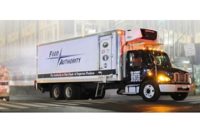When it comes to installing or expanding a company’s fleet, it’s critical to ask the right questions, including:
- What is the potential return on investment?
- What is the time horizon, meaning short or long term?
- How does this investment impact other decisions you make as a company?
- Is the business generating the capital necessary to fund the investment and other commitments?
- What is the exit strategy if things don’t go as planned?
The challenge most companies face is ensuring these decisions are based on financial and operational facts rather than being clouded by unanswered theoretical questions. And, in many ways, fleet management is a microcosm of this intricate business dynamic.
To navigate capital spending and take better control of the balance sheet, removing uncertainty is vital. One way to do this is to leverage the power of technology and advanced data analytics to develop a comprehensive acquisition strategy.
What factors should drive your fleet investment strategy?
When acquiring new fleet vehicles, there are several key factors that should always be considered, including how the needs of the fleet align with and support the overall objectives of the company. Developing a sound acquisition strategy begins with determining how these assets will contribute to the sustained success and growth of the business.
Once you have determined how the fleet will align with and support your business, here are a few additional factors to consider:
- Depending on the timeframe, how significant is the impact of these acquisitions to your company’s available capital or cash flow? Be sure to consider the initial acquisition expense and the full term of the lease or loan payments and how these may adjust your fiscal outlook.
- What’s the direction of your company, and how will these units impact both short-term goals and long-term strategic priorities?
- What are all of the possible alternatives – cash purchase, lease, financing – and is this the most beneficial way to allocate your available capital?
- Is it important for your organization to diversify financing sources? Do you want to tie-up bank lines to pay for fleet vehicles or diversify by leasing vehicles?
The answers to these questions will ultimately help to clarify the lease vs. purchase decision. Also, keep in mind that the answers to these questions may change over time, which means it’s important to reassess the strategy on a regular basis. Additionally, the implementation of new American and international accounting standards and the potential for tax reform loom on the horizon, potentially impacting your long-term strategy as well.
For many companies, there has always been a perceived fear of leasing; a myth that the company would end up paying more in terms of total cost of ownership as compared to owning a vehicle outright. Now more than ever, technology is changing that perception by transforming historical data into actionable information that highlights the true total cost of ownership for each acquisition scenario. And, when the data reveals the actual cost of ownership, leasing often becomes a more attractive option.
Informed decisions built on comprehensive analysis
By effectively leveraging data, not only will you know which vehicles are costing you the most, but also why they are costing you the most. Is a particular leasing scenario inflating costs because your company isn’t cycling them out of service at the proper time? Is purchasing vehicles restricting the cash flow of the company, negatively impacting other core areas of the business?
By taking the time to perform an in-depth analysis and asking the right questions, you gain clarity and ensure you’re making important business decisions on factual information supported by historical data – not just intuition or estimation. Allow this to guide your strategy and tailor acquisition models to the unique characteristics of the business.
Armed with this valuable business insight and supported by comprehensive data analytics, you can accurately forecast the outcome of virtually any acquisition scenario. By removing uncertainty, you will be empowered to make the best possible decision for your organization. In turn, create a fleet that is no longer a cost to the company, but rather a strategic asset that delivers value and helps the business generate revenue.



